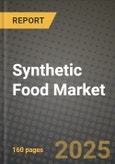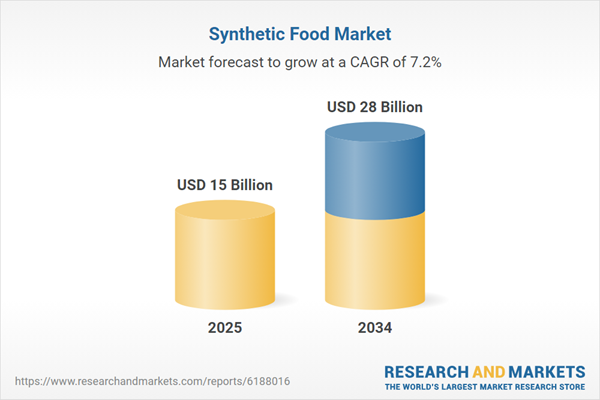The synthetic food market is emerging as a transformative force within the global food and beverage industry, offering novel solutions to address sustainability, health, and food security challenges. Synthetic food - encompassing lab-grown meat, cultured dairy, synthetic flavors, and precision-fermented proteins - leverages biotechnology and food science to replicate or enhance natural food products without relying on conventional farming. Consumers are increasingly drawn to synthetic alternatives for their ethical, environmental, and sometimes nutritional advantages, especially amid growing concerns over animal welfare, greenhouse gas emissions, and resource-intensive agriculture. From meat alternatives to bioengineered dairy proteins, synthetic foods are breaking into mainstream retail channels and finding acceptance across various demographics. Venture capital investment, regulatory interest, and shifting dietary habits are collectively propelling the market into a high-growth phase, making synthetic food a cornerstone of future food innovation strategies.
The synthetic food market gained considerable traction across regions, fueled by commercial launches, regulatory milestones, and consumer curiosity. Lab-grown meat received approvals in select countries for limited retail and restaurant sales, sparking excitement and debate around cultured meat’s role in food systems. Companies specializing in precision fermentation expanded their product portfolios to include synthetic egg whites, dairy proteins, and alternative fats - many of which were integrated into plant-based packaged foods and foodservice menus. Advancements in microbial engineering and bioreactor efficiency allowed startups to scale operations at reduced costs. Meanwhile, global food brands entered strategic partnerships with synthetic food developers to co-create hybrid products blending natural and synthetic ingredients. Sustainability narratives played a strong role in marketing, as consumers showed a growing willingness to try lab-grown products, particularly in urban and climate-conscious segments. Despite continued skepticism among traditional food audiences, awareness and acceptance saw a noticeable uptick.
The synthetic food market is expected to evolve rapidly as production technologies become more scalable, regulatory frameworks become clearer, and consumer education continues to improve. Future developments will likely focus on enhancing taste profiles, improving texture, and reducing price gaps compared to conventional foods. Countries will begin to establish harmonized labeling standards and food safety protocols, giving manufacturers clearer paths to market. Growth in functional foods and personalized nutrition will drive demand for bioengineered ingredients tailored to specific dietary needs, such as allergen-free dairy or high-protein cultured meats. In the longer term, synthetic food will also expand into humanitarian aid, space food, and climate-resilient nutrition strategies. However, mass adoption may still face resistance due to cultural, economic, and perceptual barriers. Addressing these concerns will require continued investment in transparency, traceability, and taste improvement to position synthetic foods as viable, trustworthy alternatives to traditional options.
Key Insights: Synthetic Food Market
- Expansion of precision fermentation platforms to create synthetic dairy, egg, and fat analogs for integration into plant-based and processed foods.
- Growing involvement of global food and beverage giants in synthetic food partnerships to co-develop market-ready hybrid and functional food products.
- Increasing consumer openness to lab-grown meat and synthetic proteins, especially in regions with strong sustainability and animal welfare advocacy.
- Advances in bioreactor technology and cell culture media are reducing production costs and improving scalability of lab-grown food solutions.
- Rising interest in synthetic food applications for space missions, military rations, and climate-disrupted food supply chains.
- Heightened concerns over the environmental footprint of livestock agriculture are encouraging investment in low-impact synthetic food technologies.
- Rising global protein demand, driven by population growth and dietary shifts, is spurring the search for sustainable protein alternatives.
- Supportive regulatory frameworks in innovation-led economies are enabling pilot-scale commercial launches and research collaborations.
- Health-conscious consumers are driving demand for clean-label, cruelty-free food products with scientifically enhanced nutritional profiles.
- Widespread consumer skepticism about the safety, naturalness, and long-term health implications of synthetic food products remains a significant barrier, requiring proactive transparency, regulatory assurance, and sensory innovation to build lasting consumer trust and ensure broader market adoption.
Synthetic Food Market Segmentation
By Product
- Synthetic Color
- Enzymes
- Hydrocolloids
- Antioxidants
- Flavor and Fragrances
- Fats and Oils
By Distribution
- Supermarkets
- Conventional Stores
- Online
By Application
- Beverages
- Dairy and Frozen Products
- Bakery and Confectionery
- Meat
- Poultry and Seafood
- Processed Food
- Convenience Food and Beverages
- Sauces and Dressings
Key Companies Analysed
- BASF SE
- Archer Daniels Midland Company
- Royal DSM N.V
- FMC Corporation
- Symrise AG
- Döhler Group SE.
- Chr. Hansen A/S
- Young Living Essential Oils LC
- Beyond Meat
- Naturex S.A.
- Believer Meats
- Impossible Foods
- Flavorchem Corporation
- UPSIDE Foods Inc.
- Allied Biotech Corp.
- Mosa Meat
- Falcon Essential Oils
- Aarkay Food Products Ltd.
- Meatable
- Aleph Farms Ltd.
- Motif FoodWorks Inc.
- GOOD Meat
- SuperMeat
- IntegriCulture Inc.
- Fiorio Colori S.R.L
- Multus Biotechnology Ltd.
- BioBetter Ltd.
- Frutarom Industries Ltd.
Synthetic Food Market Analytics
The report employs rigorous tools, including Porter’s Five Forces, value chain mapping, and scenario-based modeling, to assess supply-demand dynamics. Cross-sector influences from parent, derived, and substitute markets are evaluated to identify risks and opportunities. Trade and pricing analytics provide an up-to-date view of international flows, including leading exporters, importers, and regional price trends.Macroeconomic indicators, policy frameworks such as carbon pricing and energy security strategies, and evolving consumer behavior are considered in forecasting scenarios. Recent deal flows, partnerships, and technology innovations are incorporated to assess their impact on future market performance.
Synthetic Food Market Competitive Intelligence
The competitive landscape is mapped through proprietary frameworks, profiling leading companies with details on business models, product portfolios, financial performance, and strategic initiatives. Key developments such as mergers & acquisitions, technology collaborations, investment inflows, and regional expansions are analyzed for their competitive impact. The report also identifies emerging players and innovative startups contributing to market disruption.Regional insights highlight the most promising investment destinations, regulatory landscapes, and evolving partnerships across energy and industrial corridors.
Countries Covered
- North America - Synthetic Food market data and outlook to 2034
- United States
- Canada
- Mexico
- Europe - Synthetic Food market data and outlook to 2034
- Germany
- United Kingdom
- France
- Italy
- Spain
- BeNeLux
- Russia
- Sweden
- Asia-Pacific - Synthetic Food market data and outlook to 2034
- China
- Japan
- India
- South Korea
- Australia
- Indonesia
- Malaysia
- Vietnam
- Middle East and Africa - Synthetic Food market data and outlook to 2034
- Saudi Arabia
- South Africa
- Iran
- UAE
- Egypt
- South and Central America - Synthetic Food market data and outlook to 2034
- Brazil
- Argentina
- Chile
- Peru
Research Methodology
This study combines primary inputs from industry experts across the Synthetic Food value chain with secondary data from associations, government publications, trade databases, and company disclosures. Proprietary modeling techniques, including data triangulation, statistical correlation, and scenario planning, are applied to deliver reliable market sizing and forecasting.Key Questions Addressed
- What is the current and forecast market size of the Synthetic Food industry at global, regional, and country levels?
- Which types, applications, and technologies present the highest growth potential?
- How are supply chains adapting to geopolitical and economic shocks?
- What role do policy frameworks, trade flows, and sustainability targets play in shaping demand?
- Who are the leading players, and how are their strategies evolving in the face of global uncertainty?
- Which regional “hotspots” and customer segments will outpace the market, and what go-to-market and partnership models best support entry and expansion?
- Where are the most investable opportunities - across technology roadmaps, sustainability-linked innovation, and M&A - and what is the best segment to invest over the next 3-5 years?
Your Key Takeaways from the Synthetic Food Market Report
- Global Synthetic Food market size and growth projections (CAGR), 2024-2034
- Impact of Russia-Ukraine, Israel-Palestine, and Hamas conflicts on Synthetic Food trade, costs, and supply chains
- Synthetic Food market size, share, and outlook across 5 regions and 27 countries, 2023-2034
- Synthetic Food market size, CAGR, and market share of key products, applications, and end-user verticals, 2023-2034
- Short- and long-term Synthetic Food market trends, drivers, restraints, and opportunities
- Porter’s Five Forces analysis, technological developments, and Synthetic Food supply chain analysis
- Synthetic Food trade analysis, Synthetic Food market price analysis, and Synthetic Food supply/demand dynamics
- Profiles of 5 leading companies - overview, key strategies, financials, and products
- Latest Synthetic Food market news and developments
Additional Support
With the purchase of this report, you will receive:- An updated PDF report and an MS Excel data workbook containing all market tables and figures for easy analysis.
- 7-day post-sale analyst support for clarifications and in-scope supplementary data, ensuring the deliverable aligns precisely with your requirements.
- Complimentary report update to incorporate the latest available data and the impact of recent market developments.
This product will be delivered within 1-3 business days.
Table of Contents
Companies Mentioned
- BASF SE
- Archer Daniels Midland Company
- Royal DSM N.V
- FMC Corporation
- Symrise AG
- Döhler Group SE.
- Chr. Hansen A/S
- Young Living Essential Oils LC
- Beyond Meat
- Naturex S.A.
- Believer Meats
- Impossible Foods
- Flavorchem Corporation
- UPSIDE Foods Inc.
- Allied Biotech Corp.
- Mosa Meat
- Falcon Essential Oils
- Aarkay Food Products Ltd.
- Meatable
- Aleph Farms Ltd.
- Motif FoodWorks Inc.
- GOOD Meat
- SuperMeat
- IntegriCulture Inc.
- Fiorio Colori S.R.L
- Multus Biotechnology Ltd.
- BioBetter Ltd.
- Frutarom Industries Ltd.
Table Information
| Report Attribute | Details |
|---|---|
| No. of Pages | 160 |
| Published | October 2025 |
| Forecast Period | 2025 - 2034 |
| Estimated Market Value ( USD | $ 15 Billion |
| Forecasted Market Value ( USD | $ 28 Billion |
| Compound Annual Growth Rate | 7.1% |
| Regions Covered | Global |
| No. of Companies Mentioned | 28 |









